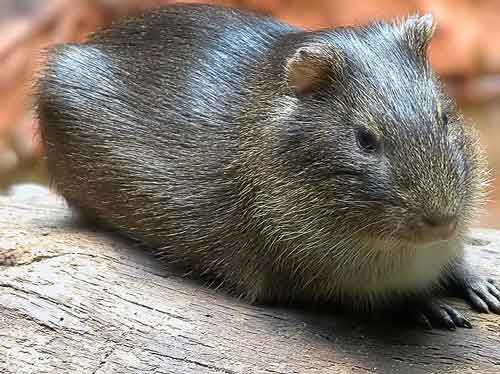
Cavia aperea (*)
Superregnum: Eukaryota
Cladus: Unikonta
Cladus: Opisthokonta
Cladus: Holozoa
Regnum: Animalia
Subregnum: Eumetazoa
Cladus: Bilateria
Cladus: Nephrozoa
Superphylum: Deuterostomia
Phylum: Chordata
Subphylum: Vertebrata
Infraphylum: Gnathostomata
Megaclassis: Osteichthyes
Cladus: Sarcopterygii
Cladus: Rhipidistia
Cladus: Tetrapodomorpha
Cladus: Eotetrapodiformes
Cladus: Elpistostegalia
Superclassis: Tetrapoda
Cladus: Reptiliomorpha
Cladus: Amniota
Cladus: Synapsida
Cladus: Eupelycosauria
Cladus: Sphenacodontia
Cladus: Sphenacodontoidea
Cladus: Therapsida
Cladus: Theriodontia
Cladus: Cynodontia
Cladus: Eucynodontia
Cladus: Probainognathia
Cladus: Prozostrodontia
Cladus: Mammaliaformes
Classis: Mammalia
Subclassis: Trechnotheria
Infraclassis: Zatheria
Supercohors: Theria
Cohors: Eutheria
Infraclassis: Placentalia
Cladus: Boreoeutheria
Superordo: Euarchontoglires
Ordo: Rodentia
Subordo: Hystricomorpha
Infraordo: Hystricognathi
Parvordo: Caviomorpha
Familia: Caviidae
Subfamilia: Caviinae
Genus: Cavia
Species: Cavia aperea
Name
Cavia aperea Erxleben, 1777
Vernacular names
čeština: Morče divoké
Deutsch: Gemeines Meerschweinchen
English: Brazilian Guinea Pig
español: Apereá
português: Preá
Runa Simi: Sach'a quwi
Tiếng Việt: Chuột lang Brasil
The Brazilian guinea pig (Cavia aperea) (preá in Portuguese) is a guinea pig species found in Argentina, Brazil, Bolivia, Colombia, Ecuador, Guyana, Paraguay, Uruguay and Venezuela.[2]
Cavia aperea has been successfully mated to the domestic guinea pig, Cavia porcellus, though many females become infertile in successive generations.[3] Brazilian guinea pigs are mainly diurnal animals and are narrower and longer than domesticated guinea pigs.
Description
This is a medium-sized guinea pig with an adult length of about 272 mm (11 in) and a weight of 637 grams (22.5 oz). The tail, at around 2.4 mm, is almost non-existent. The dorsal fur is dark olive-brown mixed with brown and black, and the underparts are a pale grey or yellowish-grey.[4]
Its karyotype has 2n = 64 and a reportedly variable FN of 116 or 128 for C. a. aperea and 128 for C. a. pamparum.[1]
Distribution
The Brazilian guinea pig has a wide distribution in South America at altitudes between 400 and 3,000 metres (1,300 and 9,800 ft) above sea level. Its range extends from Colombia, Ecuador and Venezuela to northern Argentina. Its typical habitat is open grassland and savannah.[2]
Behaviour
Cavia aperea is a herbivore and feeds on grasses and other herbs. It is diurnal, mainly emerging in the early morning to forage and again in the evening. It does not dig a burrow, but makes an intricate maze of surface tunnels that are 8 to 12 cm (3 to 5 in) wide. It has latrine areas beside the trackways where piles of bean-shaped droppings can be seen, as can piles of cut grass stems.[4]
Breeding takes place at any time of year but mostly in the austral summer. The gestation period is about 62 days and females can have five litters in a year. The number of young born averages two and ranges from one to five. The minimum age at which the young adults can breed is thirty days.[4]
Status
The Brazilian guinea pig has a wide range and no particular threats have been identified. It is a common species with a stable population and, as well as living in open savannah country, it is capable of adapting to disturbed habitats. For these reasons, the International Union for Conservation of Nature has rated its conservation status as "least concern".[2]
References
Woods, C.A.; Kilpatrick, C.W. (2005). "Infraorder Hystricognathi". In Wilson, D.E.; Reeder, D.M (eds.). Mammal Species of the World: A Taxonomic and Geographic Reference (3rd ed.). Johns Hopkins University Press. pp. 1552–1553. ISBN 978-0-8018-8221-0. OCLC 62265494.
Bernal, N. (2016). "Cavia aperea". IUCN Red List of Threatened Species. 2016: e.T86257782A22189256. doi:10.2305/IUCN.UK.2016-2.RLTS.T86257782A22189256.en. Retrieved 18 November 2021.
Weir, Barbara J. (1974), "Notes on the Origin of the Domestic Guinea-Pig", in Rowlands, I. W.; Weir, Barbara J. (eds.), The Biology of Hystricomorph Rodents, Academic Press, pp. 437–446, ISBN 0-12-613334-4
John F. Eisenberg; Kent H. Redford (2000). Mammals of the Neotropics, Volume 3: Ecuador, Bolivia, Brazil. University of Chicago Press. p. 455. ISBN 978-0-226-19542-1.
Retrieved from "http://en.wikipedia.org/"
All text is available under the terms of the GNU Free Documentation License

